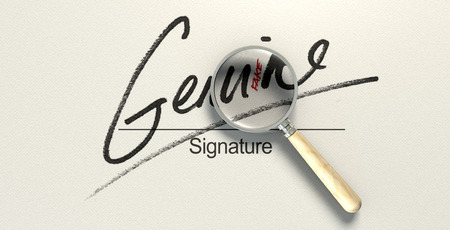It is common knowledge that as a Forensic Document Examiner, it is the person’s responsibility to provide a resource in terms of expertise for resolving alleged forged document issues in civil and criminal cases. For clarification purposes, the term ‘forgery’ is a legal term that is used to broadly define the intentional falsification of a signature or document, although there are several sub-classifications of this term as well, which depend on what kind of forgery or falsification it is. It is normally the result of the sinister intent by a person to deceive another or a legal body for financial or influential gain.

It is commonly believed that there are two of the most common types of forgery cases are signature fabrications and document alterations. Document examiners are professionally trained individuals that analyze signatures and handwriting during their primary training and furthermore their own practice as well. Some individuals also receive training at different professional conferences depending on the technique each year. To determine if the questioned writing is genuine or not, it is compared with known specimens of the purported writer such as a note or a diary or sometimes as simple as a check, although the more samples there are the better.
Common examinations include signatures on wills, contracts, mortgage documents and checks. You may have a different writing issue such as a threatening note, a sexually harassing message, diary entries, etc. Commonly, Forensic Document Examiners in their private practice receive more will and estate related document cases than any other type.
A variation of a common free-hand signature simulation, is a “cut and paste” fabrication. However, nothing is sacred in the world of cut and paste document deceptions. In addition to signatures, Forensic Document Examiners have identified similar processes used for the transfer of notary signatures and seals as well as other official stamps.
Clients are also victimized by the alteration of documents in other ways. Think of data on contracts, journals, inventory lists, time sheets, or medical records. Writing or numerals may be added, deleted or obliterated for a self-serving purpose.
A document examiner will use various laboratory instruments to resolve such issues. For example, a Video Spectral Comparator (VSC) is designed to examine inks in the infrared and ultra violet light spectrums.
The Forensic Document Examiners (handwriting experts) in most professional offices have been asked to examine photocopied documents to determine if the copies are mechanical fabrications. Another term for a mechanical fabrication is a “cut and paste”. With the accessibility of desktop publishing so prevalent in today’s society, a “cut and paste” can be done with relative ease with only a computer and a scanner. A “cut and paste” can be very rudimentary or very sophisticated, it all depends on the time and effort one wants to put into creating the document.
As one can see the handwriting expert does not always fulfill the role of handwriting expert. The Forensic Document Examiner commonly referred to as a handwriting expert, conducts a myriad of examinations on documents called into question.
